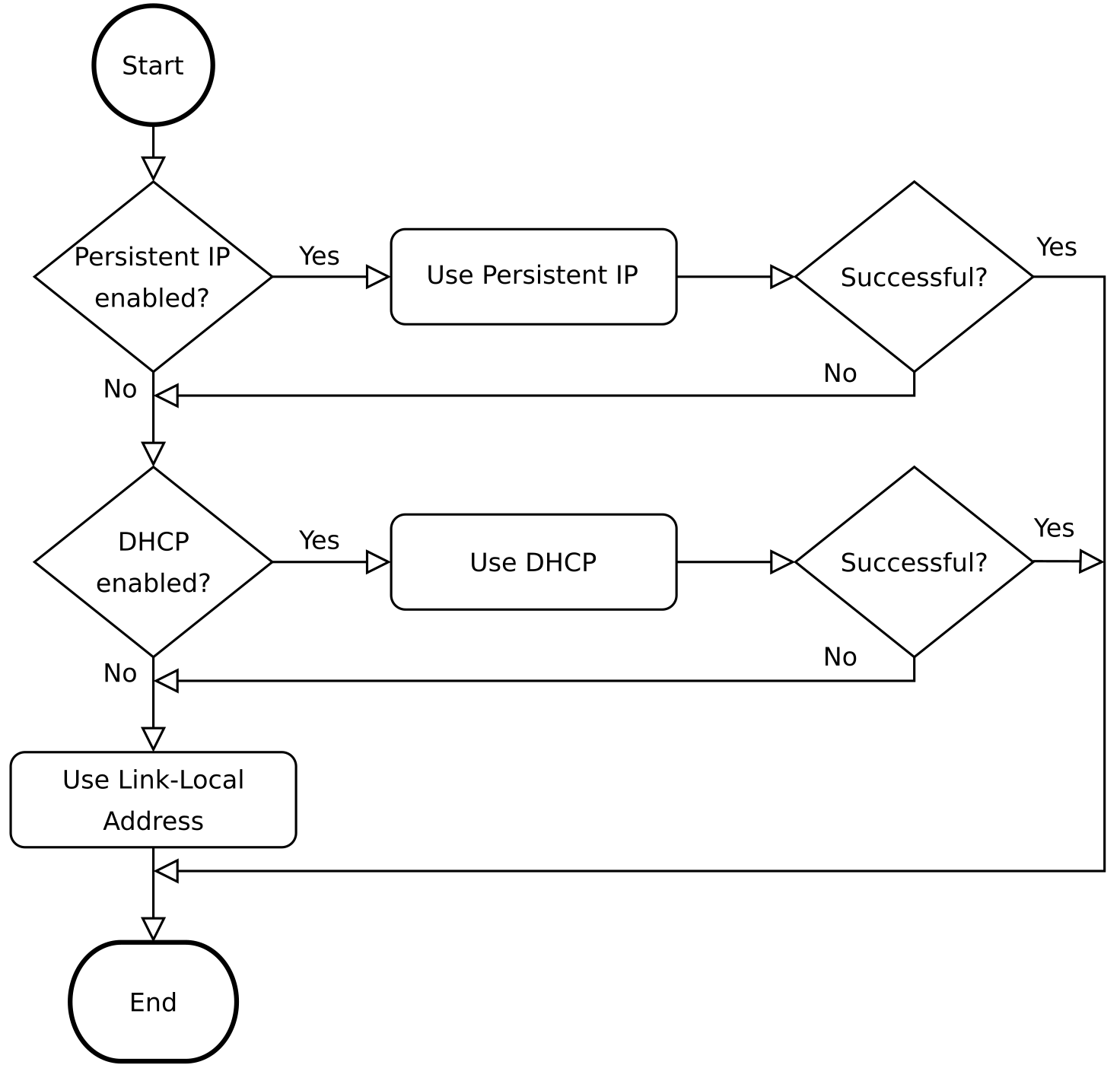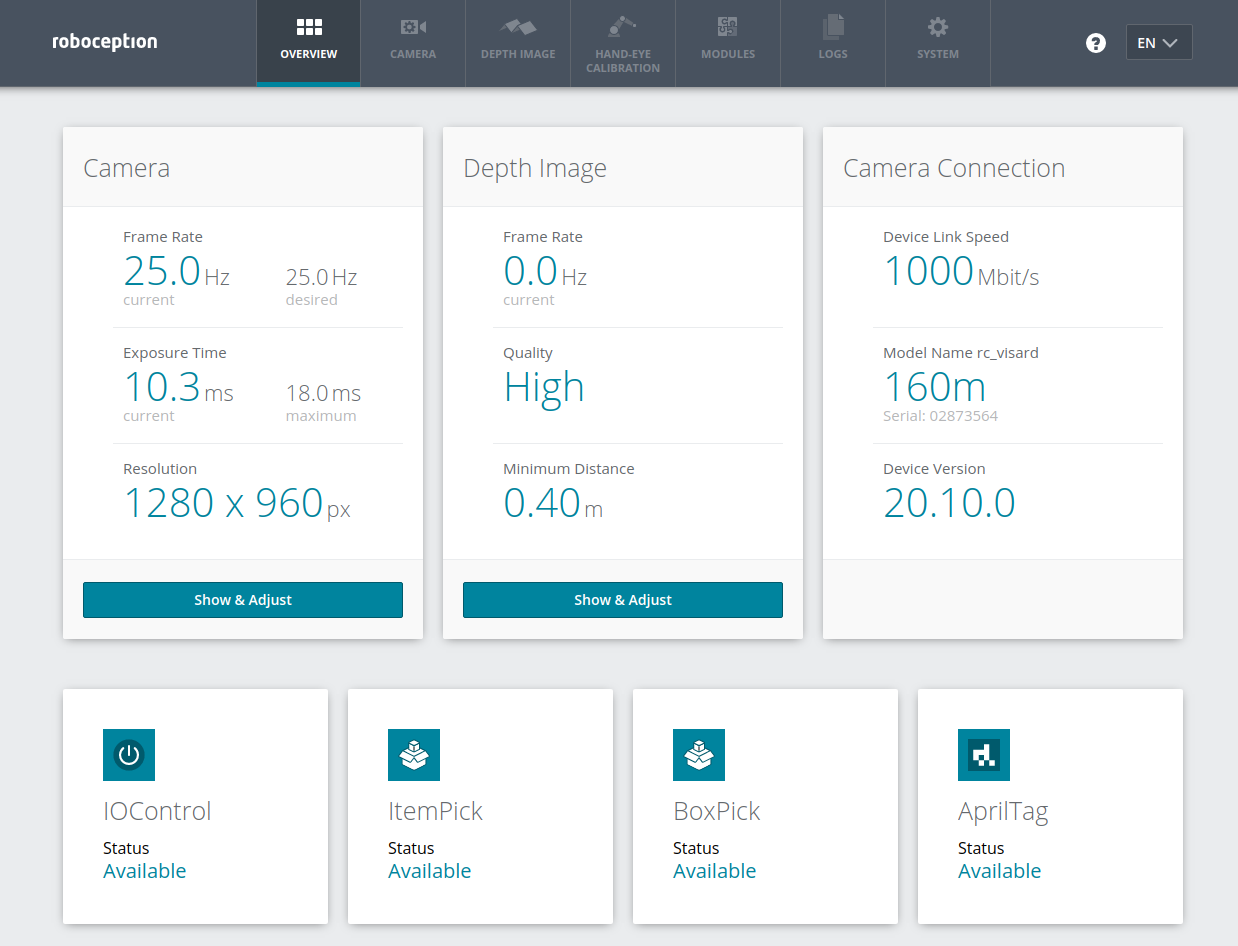Installation¶
Warning
The instructions on Safety related to the rc_cube must be read and understood prior to installation.
Installation and configuration¶
The rc_cube offers two Gigabit Ethernet interfaces: one for connecting the device to a local computer network, and the other for connecting the rc_visard. Both are marked with respective labels. All other Ethernet ports are disabled.
For commissioning, operation, or troubleshooting the user can connect input devices such as a mouse and a keyboard as well as a computer screen directly to the rc_cube. However, this is optional as the functionality of the rc_cube is fully accessible via the local network it is connected to.
Note
If a screen is used on the rc_cube, it must be connected before booting, or the rc_cube must be restarted to activate the screen.
Software license¶
Every rc_cube device ships with a USB dongle for licensing and protection of the installed software packages. The purchased software licenses are installed on and are bound to this dongle and its ID.
The functionality of the rc_cube can be enhanced anytime by upgrading the license, e.g., for optionally available software components.
Note
The rc_cube requires to be rebooted whenever the installed licenses have changed.
Note
The dongle ID and the license status can be retrieved via the rc_cube’s various interfaces such as the System tab of the Web GUI.
Note
For the software components to be properly licensed, the USB dongle must be plugged to the rc_cube before power up.
Note
The rc_cube requires to be rebooted, whenever the license dongle is plugged to or unplugged from the device.
Power up¶
The rc_cube is booted by using the power switch on the device. If a computer screen is connected it will display the rc_cube’s Web GUI when the boot process is finished.
Note
For successful operation please make sure that the rc_visard being connected to the rc_cube is powered and booted.
Discovery of rc_cube devices¶
Roboception devices that are powered up and connected to the local network or directly to a computer can be found using the standard GigE Vision® discovery mechanism.
Roboception offers the open-source tool rcdiscover-gui, which can be downloaded free of charge from
http://www.roboception.com/download for Windows and Linux.
The tool’s Windows version consists of a single executable for Windows 7 and Windows 10, which can be executed without installation.
For Linux an installation package is available for Ubuntu.
At startup, all available GigE Vision® devices – including rc_cube devices – are listed with their names, serial numbers, current IP addresses, and unique MAC addresses. The discovery tool finds all devices reachable by global broadcasts. Misconfigured devices that are located in different subnets than the application host may also be listed. A tickmark in the discovery tool indicates whether devices are actually reachable via a web browser.
After successful discovery, a double click on the device row opens the Web GUI of the device in the operating system’s default web browser. Google Chrome or Mozilla Firefox is recommended as web browser.
Resetting configuration¶
Note
The rcdiscover-gui resetting mechanism is currently not implemented for rc_cube devices.
Network configuration¶
The rc_cube requires an Internet Protocol (IP) address for communication with other network devices. The IP address must be unique in the local network, and can be set either manually via a user-configurable persistent IP address, or automatically via DHCP. If none of these IP configuration methods apply, the rc_cube falls back to a Link-Local IP address.
The network settings of the rc_visard that is used in combination with the rc_cube are automatically configured when the rc_visard is connected to the rc_cube.
Warning
To not conflict with the internal network between the rc_cube and
the connected rc_visard, the IP address assigned to the rc_cube in the
local network must not be in the range of 172.23.42.0/24.
Following the GigE Vision® standard, the priority of IP configuration methods on the rc_cube is
- Persistent IP (if enabled)
- DHCP (if enabled)
- Link-Local

Fig. 4 rc_cube’s IP configuration method selection flowchart
Options for changing the rc_cube’s network settings and IP configuration are:
- the System tab of the rc_cube’s Web GUI – if it is reachable in the local network already, see Web GUI
- any configuration tool compatible with GigE Vision® 2.0, or Roboception’s command-line tool
gc_config. Typically, these tools scan for all available GigE Vision® devices on the network. All rc_cube devices can be uniquely identified by their serial number and MAC address, which are both printed on the device.- temporarily changing or completely resetting the rc_cube’s network configuration via Roboception’s
rcdiscover-guitool, see Discovery of rc_cube devices
Note
The command-line tool gc_config is part of Roboception’s open-source convenience layer rc_genicam_api,
which can be downloaded free of charge for Windows and Linux from http://www.roboception.com/download.
Host name¶
The rc_cube’s host name is based on its serial number, which is printed on the device, and
is defined as rc-cube-<serial number>.
Automatic configuration (factory default)¶
The Dynamic Host Configuration Protocol (DHCP) is preferred for setting an IP address. If DHCP is active on the rc_cube, which is the factory default, the device tries to contact a DHCP server at startup and every time the network cable is being plugged in. If a DHCP server is available on the network, the IP address is automatically configured.
In some networks, the DHCP server is configured so that it only accepts known devices. In this case, the Media Access Control address (MAC address), which is printed on the device label, needs to be configured in the DHCP server. At the same time, the rc_cube’s host name can also be set in the Domain Name Server (DNS). Both MAC address and host name should be sent to the network administrator for configuration.
If the rc_cube cannot contact a DHCP server within about 15 seconds after startup, or after plugging in the network cable, it assigns itself a unique IP address. This process is called Link-Local. This option is especially useful for connecting the rc_cube directly to a computer. The computer must be configured for Link-Local as well. Link-Local might already be configured as a standard fallback option, as it is under Windows 10. Other operating systems such as Linux require Link-Local to be explicitly configured in their network managers.
Manual configuration¶
Specifying a persistent, i.e. static IP address manually might be useful in some cases. This address is stored on the rc_cube to be used on device startup or network reconnection. Please make sure the selected IP address, subnet mask and gateway will not cause any conflicts on the network.
Warning
The IP address must be unique within the local network and within the local network’s range of valid addresses. Furthermore, the subnet mask must match the local network; otherwise, the rc_cube may become inaccessible. This can be avoided by using automatic configuration as explained in Automatic configuration (factory default).
If this IP address cannot be assigned, e.g. because it is already used by another device in the network, IP configuration will fall back to automatic configuration via DHCP (if enabled) or a Link-Local address.
Web GUI¶
The rc_cube’s Web GUI can be used to test, calibrate, and configure the device.
It can be accessed from any web browser, such as Firefox, Google Chrome, or Microsoft Edge, via
the rc_cube’s IP address. The easiest way to access the Web GUI is to simply double click on the
desired device using the rcdiscover-gui tool as explained in Discovery of rc_cube devices.
Alternatively, some network environments automatically configure the unique host name of
the rc_cube in their Domain Name Server (DNS). In this case, the Web GUI can also be
accessed directly using the URL http://<host-name> by
replacing <host-name> with the device’s host name.
For Linux and Mac operating systems, this even works without DNS via the multicast
Domain Name System (mDNS), which is automatically used if .local is appended to the
host name. Thus, the URL simply becomes http://<host-name>.local.
The Web GUI’s overview page gives the most important information about the device and the software components.

Fig. 5 Overview page of the rc_cube’s Web GUI
The page’s top row permits access to the individual pages of the rc_cube’s Web GUI:
- Camera
- shows a live stream of the left and right rectified camera images. The frame rate can be reduced to save bandwidth when streaming to a GigE Vision® client. Furthermore, exposure can be set manually or automatically. See Parameters for more information.
- Depth Image
- shows a live stream of the left rectified, depth, and confidence images. The page contains various settings for depth-image computation and filtering. See Parameters for more information.
- Hand-Eye-Calibration
- allows the computation of the static transformation between the camera and a coordinate system known in the robot system. This can be the flange coordinate system of a robotic arm if the camera is attached to the flange. Alternatively, the camera may be mounted statically in the robot environment and calibrated to any other static frame known in the robot system. See Hand-eye calibration for more information.
- Modules
- gives access to the optional software components of the rc_cube (see Optional software components).
- Logs
- permits access to the log files on the rc_cube. The log files are typically checked if errors are suspected.
- System
- gives access to general settings and device information, and permits the firmware or the license file to be updated.
Note
Changed parameters are not persistent and will be lost when restarting the rc_cube unless they are saved by pressing the Save button before leaving the corresponding page.
Note
Further information on all parameters in the Web GUI can be obtained by pressing the Info button next to each parameter.
Access to rc_visard Web GUI¶
For troubleshooting, users can
also directly access the Web GUI of the rc_visard device that
is connected to the rc_cube.
It is available at port 2342 of the rc_cube, and hence at
the URL http://<host>:2342
where <host> is the IP address or host
name of the rc_cube that the rc_visard is connected to.
By this means, users have access to rc_visard’s device information or log files.
Note
If a computer screen is directly connected to the rc_cube, it shows the Web GUI with a small additional menu from which the rc_visard’s Web GUI can be accessed as well.
